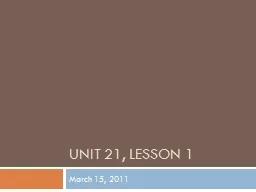

March 15 2011 W A L T Spell new words with at least 80 accuracy Recognize the schwa in words 4 of 5 trials Determine antonyms of words 8 of 10 trials Determine nouns and adjectives in sentences successfully 80 of the time ID: 168051
Download Presentation The PPT/PDF document "Unit 21, Lesson 1" is the property of its rightful owner. Permission is granted to download and print the materials on this web site for personal, non-commercial use only, and to display it on your personal computer provided you do not modify the materials and that you retain all copyright notices contained in the materials. By downloading content from our website, you accept the terms of this agreement.
Slide1
Unit 21, Lesson 1
March 15, 2011Slide2
W. A. L. T.
Spell new words with at least 80% accuracy
Recognize the schwa in words 4 of 5 trials
Determine antonyms of words 8 of 10 trials
Determine nouns and adjectives in sentences successfully 80% of the time
Utilize commas successfully at least 8 of 10 trials in sentences
Use the context clues to answer questions at least 4 of 5 trialsSlide3
1. Discover It: Schwa in Words Beginning or Ending with
a
Alike, extra, arena, among, astonish, panda, quota
Begins with an
a
Begin & Ends with an
a
Ends with an
a
alike
extra
arena
among
astonish
panda
quota
-
Schwa often occurs in words beginning or ending with
aSlide4
Workbook Page R4Slide5
Workbook Page 100
accuse
among
beautiful
extra
industry
beauty
busy
melody
opposite
business
leopard
formal
level
history
womenSlide6
1. Memorize It
Workbook page R47
The harder words to spell can be found on this page
Write it down somewhere, so that you can use this page to study later onSlide7
Workbook
Page R47Slide8
3. Unit Vocabulary
Please turn to hardcover page 87
Ident
ify any words that are unfamiliar
Clarify the word if necessary
Define the word
Clarify the definition if necessarySlide9
3. Review: Antonyms
Antonyms
are words that have opposite meanings
Examples:
What is the opposite of
separate?
What is the opposite of
delayed?
What is the opposite of
similar?
What is the opposite of
despise?
What is the opposite of
proud?
combine
instant
different
admire
ashamedSlide10
3. Multiple Meaning Map
Multiple meaning maps allow you to see a word in different contexts
It
organizes the meanings of one word
It
also helps us better understand words that have more than one meaning in the context Slide11
family
1.
A group of related plants or animals
2
.
All members of one household under one roof
3.
Relatives
4.
A group of related things
Potatoes and tomatoes belong to the same family.
My family eats dinner at 6:00.
Her family is to visit from out of town.
Related numbers belong to the same fact family.Slide12
3. Idioms
Come apart at the seams
Literal meaning
:
“have stitches joining two pieces of a garment come apart”
Idiomatic meaning
: “become so upset that you lose all self-control”More examples:
Have a skeleton in your closetRun your familySlide13
4. Review: Nouns and Adjectives
Nouns
are words that name people, places, things, or ideas
Adjectives
are words that describe nouns
Directions:
Please turn to workbook page 101
Read
the short paragrap
h
Look
at each underlined wordUse context clues to decide if the underlined word is a noun or adjective
Put
an ‘X’ in the correct columnSlide14
Workbook Page
101
X
X
X
X
X
X
X
X
X
XSlide15
4. Review: Commas in a Series
Hardcover page 92 helps us review for this
When three or more words or word groups are listed together in a sentence, the items are written one after the other.
Commas are used to separate the items
A comma is not placed in front of the first word
The last item is usually connected to the others in the series by
and or or. A comma is placed before the and
or or.Examples to follow:Slide16
4. Review: Commas in a Series
Mother father sister brother
Running and chasing each other tossing and catching the football playing a game of hopscotch
Directions:
Place commas where needed in each of the examples above
,
,
,
,
,Slide17
4. Punctuate It: Commas in a Series
Please turn to workboo
k page 102
Identify and underline the word groups in the series in the sentence
Place commas between the word groups
We will do the first one together, then do the rest independentlySlide18
Workbook Page
102
,
,
,
,
,
,
,
,
,
,Slide19
5. Independent Text:
“
Plant Families”
Before you read
What do you know about plants?
Read the first two paragraphs and discuss.
Directions:
Please turn to workbook page 102
Use
cueing questions to scoop meaningful phrases together
Answers will varySlide20
Workbook Page
102
Answers will vary!Slide21
Please read the rest of the story on your own
Hardcover pages 98-99
5. Independent Text:
“
Plant Families”Slide22
5. Use the Clues
Please turn to workbook page 103
Read the paragraph
Find each of the underlined pronouns
Identify and circle the noun or nouns that the pronoun replaces
Draw an arrow from the pronoun to th
e noun or nouns it representsSlide23
Workbook Page
103Slide24
6. Rewrite It
Please turn to workbook page 104
Read the paragraph
Identify and circle each pronoun
Identify and underline its antecedent or antecedents- the noun or nouns that the pronoun represents
Rewrite the last three sentences by combining sentences
Check the revised sentence for sentence signals- capital letters, commas, and end punctuationSlide25
Workbook Page
104
Answers will vary!
Scientists examine the stem, study the seeds, and inspect the roots.